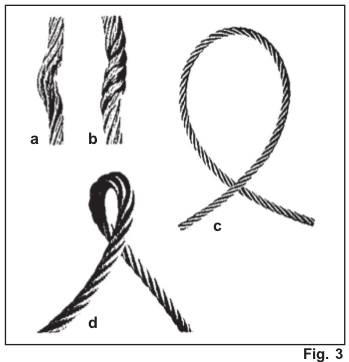| RECEIVING, INSPECTION AND STORAGE |
For all wire rope, the best time to begin taking appropriate care and handling measures, is immediately upon receiving it. On arrival, the rope should be carefully checked to make certain that the delivered product matches the description on tags, requisition forms, packing slips, purchase order and invoice.
After these necessary preliminary checks, the next concern is that of providing weather-proof storage space. If wire rope is to be kept unused for a considerable time, it must be protected from the elements. The ideal storage area is, a dry, well-ventilated building or shed. Avoid closed, unheated, tightly sealed buildings or enclosures because condensation will form when warm, moist outside (ambient) air envelops the colder rope. Although wire rope is protected by a lubricant, this is not totally effective since condensation can still occur within the small interstices between strands and wires, thereby causing corrosion problems.
On the other hand, if the delivery site conditions preclude storage in an inside space and the rope must be kept outdoors, it should be effectively covered with a waterproof material. Moreover, weeds and tall grass, in the assigned storage area, should be cut away; the reel itself should be placed on an elevated platform that will keep it from direct contact with the ground. Providing an adequate covering for the reel also prevents the original lubricant from drying out and thereby losing its protection.
Never store wire rope in areas subject to elevated temperatures. Dust and grit, or chemically laden atmospheres, are also to be avoided. Although lubricant applied at the factory offers some degree of protection, every normal precautionary measure should be taken with every coil or reel of wire rope.
Whenever wire rope remains in position on an idle machine, crane, hoist, etc., it should be coated with an appropriate protective lubricant. In these circumstances, as with ropes stored outside, moisture, in the form of condensation, rain or snow may form on the wire rope. Some of the moisture may easily become trapped inside the rope and cause corrosion problems.
If the wire rope is to be kept inactive for an extended period while wound on the drum of the idle equipment, it may be necessary to apply a coating of lubricant to each layer as the rope is wound on the drum. Cleaning, inspection and re-lubrication should precede start-up of the equipment.
| WIRE ROPE INSTALLATION – Checking the diameter |
It Is most important to check the diameter of the delivered rope before installation. This is to make certain that the rope diameter meets the specified requirements for the given machine or equipment. With an under size diameter rope, stresses will be higher than designed for and the probability of breaking the rope will be increased; an over size diameter rope will wear out prematurely. This happens because of abuse to the rope caused by pinching in the grooves of the sheave and drum.
In checking, however, the actual rope diameter must be measured. And this is defined as the diameter of the circumscribing circle, i.e., its largest cross-sectional dimension. To insure accuracy this measurement should be made with a wire rope caliper using the correct method (b) shown in Fig. 2. For measuring ropes with an odd number of outer strands, special techniques must be employed.
Design specifications for wire rope are such that the diameter is slightly larger than the nominal size, according to the allowable tolerances shown in Table 1.
|
*These limits have been adopted by the Wire Rope Technical Board (WRTB). In the case of certain special purpose ropes, such as aircraft cables and elevator ropes, each has specific requirements. If a question should arise regarding compliance with oversize tolerances, the rope may be measured under tension of not less than 10% nor |
||||||

Fig. 2: How to measure (or caliper) a wire rope correctly. Since the “true” diameter (A) lies within the circumscribed circle, always measure the larger dimension (B).
| UNREELING & UNCOILING |
Wire rope is shipped in cut lengths, either in coils or on reels. Great care should be taken when the rope is removed from the shipping package since it can be permanently damaged by improper unreeling or uncoiling. Looping the rope over the head of the reel or pulling the rope off a coil while it is lying on the ground, will create loops in the line. Pulling on a loop will, at the very least, produce imbalance in the rope and may result in open or closed kinks (Fig. 3). Once a rope is kinked, the damage is permanent, To correct this condition, the kink must be cut out, and the short ened pieces used for some other purpose.
 |
Fig. 3: Improper handling can create open (a) or closed kinks (b). The open link will open the rope lay; the closed kink will close it.
Starting loop (c): Do not allow the rope to form a loop. If, however, a loop does form and is removed at the stage Kink (d): In this case, the looped rope was put under tension, the kink was formed, the rope is permanently damaged and must be removed. |
